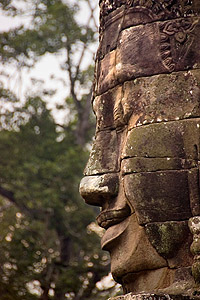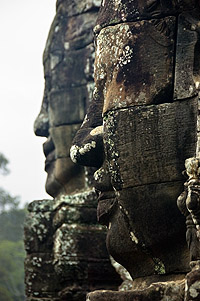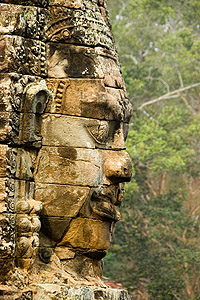Friday, 21 March 2008
Bangkok, Thailand
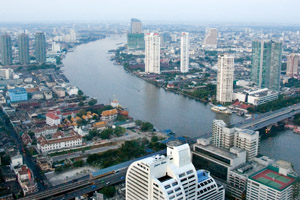
(Bangkok, Thailand)
We arrived in Bangkok at 1600. It had been a pretty enjoyable flight aided by the fact that we got upgraded to premium economy. The new airport was super modern and we managed to get through it with very little harassment and found a bus into the centre of town. The bus took a couple of hours, the traffic in Bangkok being well known for gridlocks, but around 1800 we were dumped near a metro station.
We had opted to take a bit of a gamble. Our ultimate destination was to be Angkor Wat however we had wanted more of a road trip this time round. We had therefore designed a route that would take us from Thailand into Laos then down into Cambodia along the Mekong river. This was all fine but the one stage we were not sure about was the border crossing into Cambodia. Our various attempts at talking to the Cambodian consulate in London had met with sheer bewilderment and the internet was 50/50 on the matter. So for a while we contemplated a more leisuely tour of Cambodia. However at the last minute, as our plane landed, we decided to stick our original plan and risk the border. Critical to this route, however, was getting where we needed to go fast as it was a long cicruit. So it was with some trepidation that we took the metro to Bangkok's central station.
The first leg of the journey was to traverse the flat plains of Isaan, a 600km long train journey roughly following the course of the Mun river to its junction with the Mekong. We had hoped to leave that night on a sleeper but sadly it was not meant to be, if there was a sleeper it was fully booked and all they had left were some seats in an un-air-conditioned 3rd class. Having had a similar experience in Southern India on our honeymoon, we really did not feel like sweating upright for 12 hours in an uncomfortable seat whilst rattling through the dark was the way to go. So instead we opted for an early morning train the next day and a fan assisted scond class. We found a pretty reasonable hotel, the Bangkok Centre, next to the station and settled into our room with a much needed shower.
I would like to pretend that dinner was a well organised affair but it was not! Having not intended to stay the night we had not read the guide book and at eight did not really have the energy. Curiously instead of taking a tuk tuk we just started walking in the direction of Jim Thompsons house with the assumption that there would be some fine dining near by. If there was we failed to find it and instead ended up walking for miles through closed up markets and ate at an okay, but not great, chinese run place. My red curry was mentally hot but at least we had some cool beers to drown it down with. We were the last people in the place and by the time we fininshed were more than happy to grab a tuk tuk and head back to the hotel for some much earned rest.
Saturday, 22 March 2008
Ubon Ratchathani, Thailand
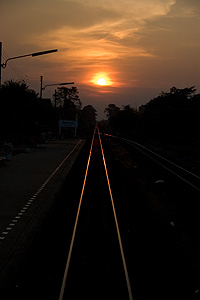
(Ubon Ratchathani, Thailand)
We woke up at 0500, packed and had some breakfast at the hotel before heading to the train station. Having been patient we had a least the benefit of some fairly good seats, essential as in Thailand there are several classes with two classes of third class - one with wooden benchlike seats which I imagine would have crippled us after a few hours. Instead we had soft seats in secnd class with the ultimate in luxury, ceiling fans. These generally come in pretty handy when your train is stuck in a siding in 35°C heat and this train ride was no exception.
Despite the luxury the trip was somewhat akin to torture. it was difficult to imagine that just under ten years ago we had endured a fifty hour bus trip in China and now a twelve hour train trip was too much for us. The big difference was whilst previous journeys had been very scenic, this instead was twelve hours of flat, dry, unending rice paddies. The only break was when we left the Chao Praya valley North of Bangkok to cut through the mountains surrounding Isaan's plain and joined the Mun valley. Even then we saw little or nothing of either river until we pulled into Ubon Ratchathani, our destination, which was situated on the Mun.
On arrival, having had enough of publc transport for the day, we leapt out of the station into a tuk tuk and headed for the hotel. Here we had a stroke of luck, when we told the receptionist we were off to Laos she produced a booklet about a direct bus. It seeemed that in the intervening years since our guidebook had been written someone had realised the opportunity of putting in a direct bus route, and what was more it was very reasonably priced. This was a godsend because the alternative sounded like hours of messing around and two changes of transport - the direct bus offered to navigate the 90km to the border, the border crossing and the 40km to Paxhe in less than 4 hours.
After a shower, to remove the dirt we had been sand blasted with all day, we discovered that Ubon itself was a bit of a ghost town. Apart from a small crowd of people at the night market next to our hotel we did not see any pedestrians on the way to the restaurant some 500m away. In retrospect Ubon turned out to be very spread out and the downtown area where we were a little run down but nevertheless it had none of the hustle and bustle of Asian towns we were used to.
The meal itself was not bad, we had picked a floating fish restaurant so that we could at least get a glimpse of the Mun. In the darkness what we saw of the Mun was little more than some brown murkiness just next to our table. The fish was good. The conversation with the waitress amusing as it took us a while to realise that she was having trouble with our phrasebook Thai because she was herself Vietnamese. After dinner we popped into the nightmarket to try some local desserts. I tried some green goo which was reminiscent of green tea mixed with coconut
Sunday, 23 March 2008
Champasak, Laos
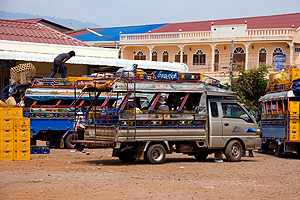
(Pakxe, Champasak, Laos)
The advertised bus was not til 0930 but we thought we had better get to the bus station as early as possible - if it did not exist we would need a lot of time to get to the border. Fortunately we were woken by the sound of the market playing Chinese classics very loudly and so we got some breakfast and checked out of the hotel by 0730. Round the corner from our hotel we found an old man with a tuk tuk and started to haggle with him for thr trip to the bus station. He started off wanting 150 baht (around £2.50) but we managed to persuade him down to a more realistic 100 baht.
The bus station was relatively easy, yes the bus existed, yes it cost only 200 baht each and yes it was leaving at 0930. Whilst Anna was buyng the ticket however something unusual did happen, they started playing the thai national anthem and unbelievably everyone in the bus station stood up. Trying to get a scale for the level of nationalism on show I decided to sit for a while. Unbelievably people started to get a bit tense and indicate for me too get up. Clearly King and country meant a lot to the Thais so I relented.
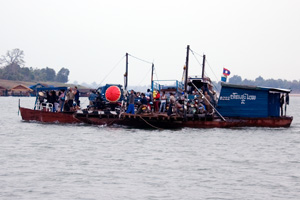
(Champasak, Laos)
The bus journey was slightly better than the train journey, it was pretty dull up to the border and then the fun began. The border had all the pomp and circumstance of the best of them. A state of the art building on the Thai side and then a no mans land followed by a selection of portacabins on the Lao side. It was not the architecture that was worrying, we forgot our passport photos in our rucksacks so at one point I went back to the bus to get them. I very easily could have got back in and smuggled myself in. The visas were relatively easy, $40 for USA, $35 for the UK and $30 for France and Germany. The only odd thing was Sweden - at $31 !! There was a money changer there and, having figured that border money changers were always bad value I decided to only change $5 worth.
Over the other side the scenery gradually improved. As we neared the Mekong mountains started to rise up and the vegetation became more dense. We crossed the river on an amazing suspension bridge and then got dropped at a non descript bus station in the centre of Pakxe. This is where it all started to go wrong money wise as we were determined to move onto the next town. Our tuk tuk driver decided to charge us 10,000kip each (around $1) for what was little more than a 300m ride (we thought we were way out to the west of town). Then he dropped us at a market which turned out not to be the correct bus station, and worst of all he started trying to push us towards various of his "friends" who would all take us to Champasak for 150,000 kip.
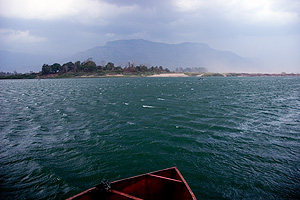
(Champasak, Laos)
We stuck it out and ignored everyone but ultimately we realised we were stuck in a market somewhere in town with no local currency. A couple of discussions later we realised that prices had possibly gone up two fold since the book was written as the cheapest we could find a lift was 20,000 kip each which was double what we had expected. It was Sunday so the banks were closed so Anna tried to find someone to change dollars but, maybe because of recent currency movements no-one was interested. Eventually by a combination of feigning disinterest and actually not having the money we finally found passage for 10,000 kip each on a converted pick up truck, or songathew, which was waiting to gather enough clients to leave. After about half an hour of deliberation followed by loading a case of beers in on top of us it finally did exactly that.
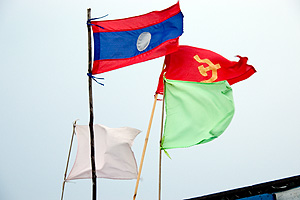
(Champasak, Laos)
The ride was fairly unventful, up to a point. The terrain was fairly parched scrubland which I suspect at some point had been jungle. We bounced around in the back along a fairly well finished road and eventually got to a point on the opposite side of the Mekong from Champasak our destination. Here we drove onto a very, very makeshift looking ferry. It was little more than three metal hull with some boards lased to the top. However on top of this they managed to perch a total of six assorted pick up trucks and several motorbikes. We were just getting ready to go when an amazing storm picked up. Blowing South down the Mekong it first presented us with incredibly strong winds, then it started to spit rain and we even had a bit of thunder. The wind was the most spectacular as it picked up sand from an island in the centre of the Mekong and flung it towards us. We had to sit it out and when it finally calmed down we set off across the Mekong.
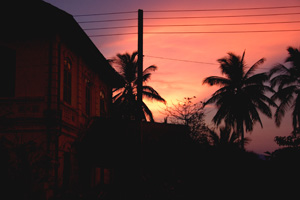
(Champasak, Laos)
On the other side we found that Champasak was little more than a series of wooden houses strung out along 4km of road. In the centre were a couple of stone built colonial era mansions one of which had belonged to the last King of Champasak, a significant kingdom which had once ruled most of the South of Laos. In terms of accomodation there were several basic guesthouses set by the banks of the Mekong however they seemed to have all run out of rooms. We shopped around for a bit and eventually found a clean, but basic, affair in a guest house on the other side of the road.
Given our currency situation getting dinner ended up being a bit of a challenge. The tradegy of the situtaion was that our guide book clearly stated that because of the instability of the Lao kip that dollars were freely intechangeable, if technically illegal. However it proved very difficult to find anyone apart from hotel owners that accepted them. We eventually found a restaurant that accepted dollars with a table overlooking the Mekong. Dinner was very nice, we had some local sausages, chicken cooked in ginger and sticky rice, all washed down with cold beer. As the red moon rose over the Mekong we reflected on what had been an eventful day.
Monday, 24 March 2008
Champasak, Laos
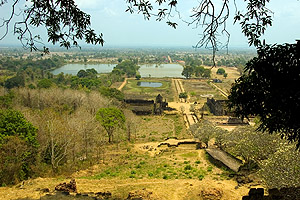
(Wat Phou, Champasak, Laos)
Waking up in Champasak is pretty much waking up in a farmyard, it starts with chickens and by around 0700 the noise is so cacophonous that you are up whether you like it or not. The aim for the day was to visit Wat Phou, a Khmer temple set on a moutain slope 10km south of Champasak. But before that we had to sort out our money situation. We got to the bank at 830 and changed $150, which translated to 1.3 million kip. I was used to being a millionaire in other currencies but it was a completely new experience to be a millionaire for £80. Predictably the wadge of notes that came out was huge, the largest denomination in circulation being 50,000kip.
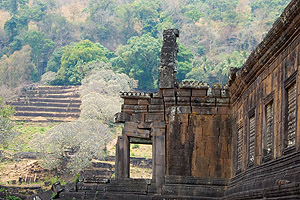
(Wat Phou, Champasak, Laos)
After this we had some breakfast, again we found a restaurant by the side of the Mekong and Anna had a passable noodle soup. We watched slowly as a passenger ship made its way up the river following a marked out central channel. This got us vaguely excited as we had heard from a couple of people so far that the boat from Champasak downstream to our next destination Si Phan Don, did not run in the dry season. However after breakfast we went to the tourist information centre and quickly found out that the rumours were true. There was no boat in the dry season, you could charter one for $200 but this seemed a bit like cheating.
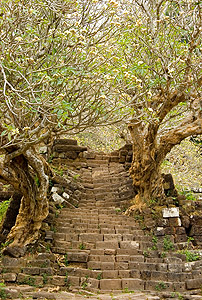
(Wat Phou, Champasak, Laos)
Going to the temple proved a lot harder than the guide book made out. Whilst at the time of writing the going rate for a tuk tuk ride was 10,000 kip it seemed to have risen in the meantime to 40,000 kip. Having worked hard to get some of the currency we ignored the first driver that told us this and carried on. Unfortunately it soon became apparent that the first driver who we negociated with was the only driver around. We passed him a couple of times before going back to the hotel to regroup, where we realised that instead we could hire a bicycle from our hotel and fairly easily cycle the 10km there as it was all on the flat.
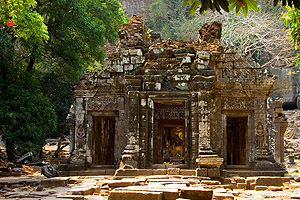
(Wat Phou, Champasak, Laos)
Wat Phou is an amazing site, initially it looks very unpromising with a couple of square baray's (huge square ponds) and some well decorated but essentially square monumental buildings. However through the middle of the site a central paved road became a very steep staircase flanked by a row of frangipani trees. The spectacle of this, since they had no leaves only perfect yellow flowers was quite gobsmacking. We worked our way up it and eventually found ourselves on a raised platform in the jungle on which rested an exquisitely carved but crumbling temple. Having been through a lot of temples it is easy to get immune to the whole thing, but the fact that: a) the way leading up to it is so special and b) there is hardly anyone at what in any other country would be a major site makes the whole deal very atmospheric.
In terms of its original inhabitants Wat Phou is generally attributed as one of the starting points of Khmer civilisation. Thus in a round about way our journey was to follow the fate of the Khmers: From their beginnings at Wat Phou through their golden age at Angkor Wat to their final capture and imprisonment by the Siamese at Attahuya (north of Bangkok which we had passed through on the train).
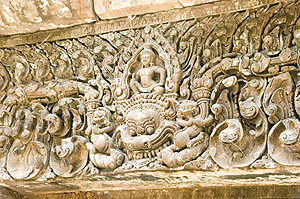
(Wat Phou, Champasak, Laos)
Cycling back was hot, not helped by the fact that we had stopped to have spring rolls for lunch just outside the temple and instead of getting 3 or 4 got a huge mountain of them accompanied by fresh mint (which we had to wash). However it was pretty pleasant ambling along the back roads watching the villagers go about their routine. There were several people building houses. These were mostly built on stilts (sensible when you consider the proximity of the Mekong) and of treated wood - with only the window frames being painted, generally in blue.
Back in Champasak we had a shower then a beer by the river side in some horrific tourist pavillion which had just been built. Since the menu and service there was bad we decided to head back to the same restaurant we had been the night before for dinner. This time however we tried local delicacy of fish steamed in banana leaves which was very tasty although we could have done with a portion each.
Tuesday, 25 March 2008
Don Khong, Champasak, Laos
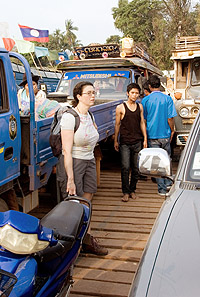
(Champasak, Laos)
We got up early to go to our next destination Si Phan Don, or the four thousand islands, a stretch of the Mekong where it divides up into many channels. Here the attempts of various 19th century adventurers to use the river to open up a route to China were stopped by a set of waterfalls. The first hop was a songathew back to the docks and yet another adventurous Mekong crossing on the make shift ferries. On the other side we conveniently found another songathew with four other travllers, a couple of french women who had been staying at our hotel, and a Northern Irish guy (the first Brit I had met so far) and his very travel sick American girlfriend. As soon as we joined we were off South towards Don Khong island.
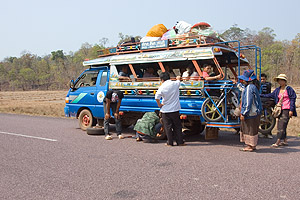
(Don Khong, Champasak, Laos)
It was a relatively eventful trip with comings and goings along the way, at one point someone even strapped their motorbike on the back. But the higlight of the trip was when, with a loud pop, one of the tires blew out and we had to stop to change it. However again the scenery was that of parched jungle with the ocassional clearing farmed during the wetter seasons. It took about two and a half hours before we found ourselves and the British/American couple deposited at a dusty road junction. Sadly from here it was about a kilometre walk to the docks and since the American girl was not feeling well we had to leave them at the junction. At the docks we found a very entrepreneurial local who took us back across the Mekong and on to Don Khong island.
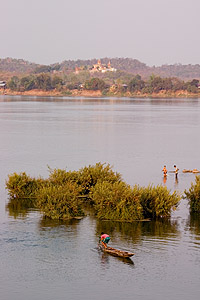
(Don Khong, Champasak, Laos)
Coming to Don Khong island from the rather shoddy Champasak was like stepping into a different world. The town in which everyone stays Muang Khong, is little more than a few streets centred on a beach front main road. We found a gorgeous restored French colonial villa - Sala Don Khong - built of teak and set by the banks of the Mekong in a lovely garden of tropical flowers. For that added touch of luxury (we had pushed the boat out on a $30 a night room) we even had a verandah with views out to the river. We had some lunch at another place on a terrace overhanging the river and retired to our room for an hour or so to relax and watch the river go past as huge bat sized butterflies flapped past.
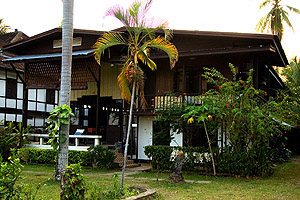
(Don Khong, Champasak, Laos)
The afternoon did not quite go according to plan. We had rented some bicycles to do a quick tour of the south of the Island. As promised the first part of the trip was very scenic, cycling on the side of the Mekong passing through bamboo groves and passing small hamlets where the children would excitedly run out to say hello to you. However just as it was going well the valve of my front wheel blew out which meant we had to turn back after completing only a quarter of the route. I had to ride back almost 5km with a flat which was not pleasant on the arms.
That night we had dinner at a great place, Mr Pons. Although the menu could have been a bit more upbeat the food was excellent. The humid atmosphere was a bit opressive however, I was continuously sweating and by the end of the night we both had a lot of insects sticking to our legs where they had died in our deet gel insect repellant.
Wednesday, 26 March 2008
Don Khong, Champasak, Laos
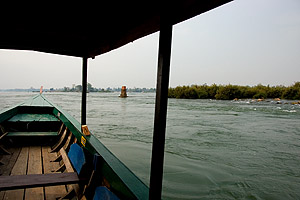
(Don Khong, Champasak, Laos)
The night before we had arranged to go for a boat cruise on the Mekong to see the famous waterfalls that blocked the progress of colonists making their way up the Mekong. However it had not been easy. The guy who had offerred us the best price of 100,000 kip was the person who ferried us over to the Island. However come 1700, the time we had arranged to meet him, he was nowhere to be found, in fact we ran into two Aussie girls looking for him in the place he said he would be. So instead we had avoided the 150,000 kip per person tour of the main backpacker hotel on the island and decided to go with our hotel, which was offering us an entire boat to ourselves for 200,000 kip with the only proviso that we would have to negotiate our own tuk tuk from a place calle Nakasang to one of the waterfalls. This turned out to be a near tragic mistake.
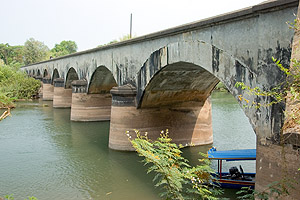
(Don Khone, Champasak, Laos)
We left at 0800 and putted down the river. There was plenty to see, life on the Mekong revolves around the Mekong - cattle drink it, monks bathe in it - children play in it. There were a lot of times I would have liked to taken a photo from our passing boat but felt it too much of an invasion. We followed a line of concrete markers, which indicated the deepest channels, that we had seen as far back as Champasak. Eventually the islands got more numerous and the channels shallower and shallower, until we found ourselves on the island of Don Det.
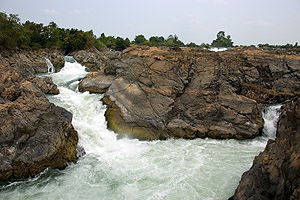
(Don Khone, Champasak, Laos)
The French having found themselves faced with a veritable cataract of rapids on the border of what is now Laos and Cambodia decided to build a railway line. This line was only to be 10km long and would haul goods coming in from the sea up over Don Khone Island, across a bridge onto Don Det Island, and from there onto a docks and back onto the Mekong. In some ways it was the ultimate in easy portage. However this colonial toy railway set was really seconded by the waterfalls themselves. We walked first 2km to Somphamit falls where the water cascaded down a series of rock pools, then walked another 2km to a beach on the side of the cataract. This second attraction was ruined by the fact that the river was a lot lower and as a result there were less places to dock boats to the nearby "dolphin house". So, instead of fewer boats. it ended up being a perfect beach with no access to the water. We decided at this point to go back which meant another 3km through desert like dried padi fields. Admittely we were foolish here not to take bikes on the island, but to be honest the whole place was like some ultimate experiment into how to slowly extract money out of various European travellers.
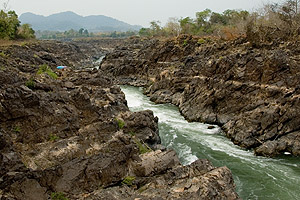
(Don Khone, Champasak, Laos)
However Don Det did not prepare us for what would come next. We were to visit Khon Phapheng, Asia's largest falls (in terms of volume) and although the drive to the nearest port was included in the price of our trip nothing else was. After another 30 mins of putting through islands we docked at a beach covered in tour boats and tour buses. Our captain was in his element, he just got off and started playing petanque. We however were latched onto by some traveller mafia local who parked our boat an then got involved in every subseuqnt negotiation. First he tried to get us into a tuk tuk for 100,000 kip. I negotiated down to 70,000 kip but Anna was not hvaing any of it. Then they tried to give us motorbikes, but the thing was it was 60,000 kip for two motorbikes and 50,000 kip for one. In the end we gave up and waited for the first group of tourists - which was a mistake because they were some Spanish guys trying to impress some Scandanavian girls. They did not know much about where they were going but we leapt in the back of their tuk tuk and payed 80,00 kip. This was it turned out a grave mistake.
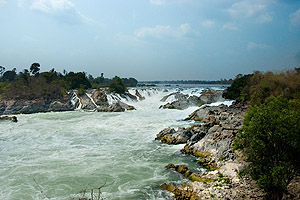
(Nakasang, Champasak, Laos)
The Spanish/Scandanavians were on some sort of tour. When we got to the waterfalls (about 15km away from the port) we asked what time we should meet them back at the van and their guide tolds us they were doing a dolphin tour and we would not be heading back to the port until 1700. This did not really work as we had to be back around 1500. So we had a bit of a shout at them for not telling us this when we got on the tuk tuk and then went to look at the waterfall.
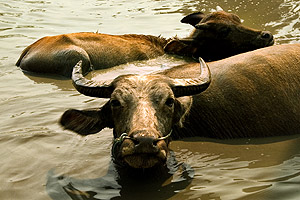
(Nakasang, Champasak, Laos)
The waterfall was petty impressive but we still had a big problem, how to get back. In the end we went for sheer brute force and walked to the junction with the main road 2km away. Here is where it started getting cazy. We thought we would never be picked up but as soon as we got to the red dust covered jungle clearing of a junction a white Landrover pulled up. A couple of Aussies shouted to us to get in the back so we did. Bizarrely we had been picked up by two Aussies working for the mine clearing effort in Laos north of Savanakehet. They had been about to cross the border to visit some chums in Cambodia when they discovered the Laotian colleage they had taken with them had no passport. The border guards had then told them they had 10 minutes to drop their colleaue at a guesthouse and come back. We had appeared on the roadside during ths mercy dash and the whole thing had looked like a pretty good trade...
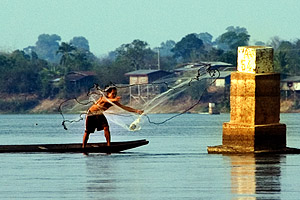
(Don Khong, Champasak, Laos)
We got dumped at the junction with Nakasang with their Lao employee who had been given 300,000 kip to go and find somewhere to stay for two nights whilst they went to Cambodia and back. It was a good trade from our part because we got a lift - and boy was it was quick because with 10 minutes to amke 20km they went very fast. From their part it was a good trade because from the evidence we did not think their Lao employee had spent much timeout of his province so was a bit shellshocked by the whole experience. We walked with hin 4km from the road back to Nakasang which was hot and dusty, then tried to help him find a guesthouse. Although he was fairly good company for the walk he seemed mesmerised - when the first guesthouse we came to seemed a little bit expensive he continued tagging along til we got back into the centre of Nakkasang and we waved goodbye to him outside a more reasonable looking place. One thing I wil never forget is when we left he said "what time will you come back tomrrow" so I had to explain again that the Australians would come back for him in two days. I was not sure he understood, but was sure they at least remembered where they left him so would come back.
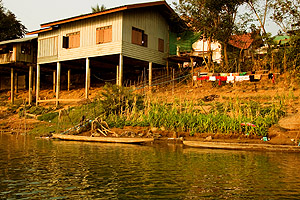
(Don Khong, Champasak, Laos)
After all this we got back to the boat only 15 minutes late and found our pilot waiting for us. We also found another couple arguing with the local transport mafia, they were in the "rent a bike" stage, so were able to give them the benefit of our advice. The journey back was spectacular, two hours slowly making our way upstream we were able to see lot of the late afternoon activities on the Mekong, including a lot of fishermen casting their nets.
Finally we pulled into Muang Khong at about five and said goodbye to our pilot. We then arranged our trip to Cambodia, things had recently become a lot easier but we were not going to get to cross by the river. Then we had an amazing dinner of the speciality of fish steamed in banana leaves again before going to sleep.
Thursday, 27 March 2008
Kratie, Cambodia
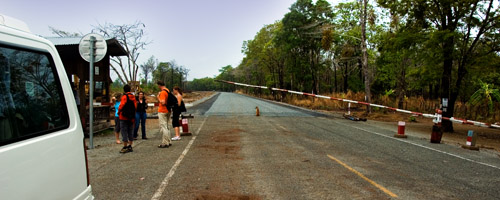
(Kratie, Cambodia)
Our fourth wedding anniversary. At about 0400 the heavens had opened and it had rained torrentially the rest of the night. We had breakfast in the cavernous entry room of our hotel watching the rain continue to fall. The guy we had arranged our trip with met us at 0830 and in the car were the two Aussie girls we had met two days before trying to arrange a boat trip. They were very pleasant company and we swapped stories all the way to the border.
We had been told that we were to be dropped at the Don Khong side of the ferry crossing and we would be picked up on the other side by another van. However our agent sensed there were some issues and rather than leaving us in the rain at the ferry port he drove us all the way to the border. Instead we spent two hours in a flea bitten cafe on the Lao border. What had seemed to be a fairly efficient organisation at the Don Khong end rapidly started to deteriorate. We were not told why we were held up - I suspect it was because we were waiting for another van of peple from Don Kone which arrived two hours after we had at the border. Anyway eventually the much more clapped out Cambodian minivan arrived and we started making our way very slowly towards the Cambodian border post. This was set amongst some very nice forest which looked like it had been left a while since the last time it was logged.
Border formalities were minimal. The visas cost us $20 each and of top of this there was a $1 tax for processing and $1 for the exit stamp. The extra dollars were I suspect very unofficial, but it does not pay to ague over such trivial amounts - our guide book had tales of people being charge $60 for their exit stamp a few years back when the crrossing was not as widely used. We then set off through Cambodia heading for Kratie and a unsettling series of incidents.
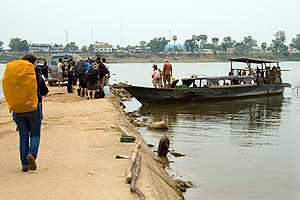
(Kratie, Cambodia)
The first incident was just after the border an oncoming van managed to wipe out two of a flock of geese crosing the road. One was killed stone dead but the other unfortunately was not. It was a bit shocking because, judging by their huts the people in the area semed to be pretty poor so this would have been a big loss for the owner. Also the van could have easily stopped in time as it was not going fast but just plainly did not care.
The second incident was less grisly but just the next installment of the degrading bus service saga. Just before Stung Treng the bus pulled off the surfaced main road and down a dusty track to the side of the Mekong. Here we were told to get out of the bus and had to march with our luggage down to a long quay at which was the most dilapidated boats that could be imagined. Faced with no option we got into the boat and sat there starring incredulously at the brand new river bridge which had been built only a km or so down river (I expect the boat was a toll dodging scheme). Then a van pulled up on the quayside and three hogs were wrestled out of the van squealing and slapped onto the prow and a chap pinned them down for the journey over. It would not have been so bad but they did not remove the hogs on the other side, we all had to clamber over them to disembark.
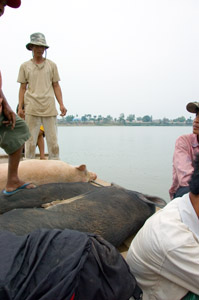
(Kratie, Cambodia)
In Stung Treng we were lead to some sort of travellers cafe on the riverside. It sounds idyllic but the neighbourhood we were in (and I suspect we were in the centre) was very grotty and made me glad we had not decided to stop there. We then had lunch and changed into a third bus, this even more dilapidated than the last where we were crammed in so they had enough room to act as an ad hoc taxi service for any Cambodians they wanted to pick up. Here the final incident took place, two young Canadian girls in our group but heading for Siem Riep got a big surprise when they found out that they would be spending the night in a place called Kampong Cham. They had either not asked or had not been told that it would take them two days and were pretty annoyed about it because they could have just as easily gone to Phnom Penh. I think everyone was a little disappointed by the bus company, the final set of drivers for example did not speak a word of English between them. However I was just glad we at least has someone to pick us up at the border (the ultimate rip off would have been leaving us there) instead what we were just the victims of ever increasing corner cutting.
We finally got into Kratie at 1600 and were beseiged by people trying to offer us rooms and trips to see the dolphins. We found a rather basic hotel, which was actually the second best in town, and then set off to explore. It turned out that Kratie was not a particularly bad place it had a fairly nice river front promenade where a lot of people hung out. There were also a couple of nice travellers cafes, one of whch had outside seating so became our base for that night. In short it was an okay place to break the journey but it looked pretty disappointing for the people who had travelled the six hours from Phnom Penh especially.
However pleasant a stop over it was it did have one disappointment in store for us. Careful reading of the guide book indicated that ferries ran all the year round from here to the next city down the river. We were fairly unsurprised to find that they did not bother with the ferries any more and so we would have to take a bus to Phonm Phen. Our attempt to travel down the Mekong by boat was a bit of a disaster through lack of research however we did manage to stay on several towns along its length and our route had more or less followed it for 700km.
Friday, 28 March 2008
Phnom Penh, Cambodia
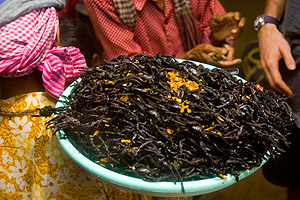
(Phnom Penh, Cambodia)
We got up at 0600 to get the bus for Phnom Penh. This turned out to be a fairly comfortable jouney compared to the previous days trials. The scenery was endless flat farmlands, but at least we got to see a slice of what life was like for Cambodias rural population. We also got to see, at the obligatory lunchtime stop, fried edible spiders - a not totally pleasant looking snack.
We got into Phnom Penh around 1300 and checked into the Holiday Villas hotel, a not too expensive Western style hotel. We then cashed some travelers checks and headed for Tuol Sleng Prison. I generally do not have a big desire to see what I perceive as negative tourist exhibits. My theory is that tourism is about having fun and visiting great achievements from the past. However everyone that had visited the former torture prison of the Khmer Rouge that we had spoken to had been profoundly touched by it.
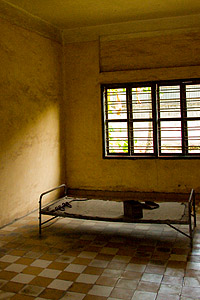
(Phnom Penh, Cambodia)
A former concrete built school Tuol Sleng had been pretty much left as it was found by the invading Vietnamese. The first set of rooms were individual torture cells which each contained an iron bed that the prisoners were mannacled to. The next building had a series of photographic exhibits. The Khmer Rouge had photographed all their prisoners and the faces of the condemned showed a bewildering mix of emotions usually fear.There was then a building which all the classrooms had been knocked through and a series of rudimentary cells, on one floor of brick, on another wood, had been built. These were tiny and it seemed impossible that someone could have lain in them. Finally there was a building with torture implements and skulls of the dead. Coming out of the prison it was diffcult for us to know what to feel.
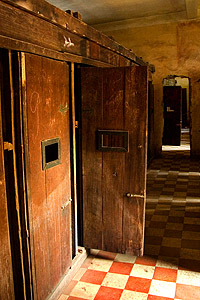
(Phnom Penh, Cambodia)
We then went to a market to get me some new shorts, my other two pairs being foolishly white they had deterioated to such a state that they were no longer fit to be seen in and public and had to be consigned to the hotel laundry. As a lot of clothing companies use SE Asian countries for their labour it is very easy to get hold of purpotedly western labels at low prices. I got a pair of Levis shorts for the bargain sum of $5.
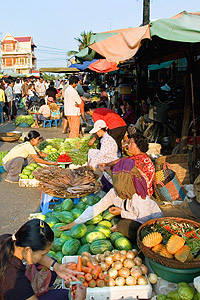
(Phnom Penh, Cambodia)
That night we had dinner at a fairly nice Khmer restaurant - Mali's. I had scallops then we had some fish dish and some beef cooked with peppers. The fish dish was very similar to dshes in Lao where the fish was mashed up and steamed ending up as a rubbery almost mousse into which a soft shell crab had been cooked. After this we went to the Green Vespa, an Irish pub, and got chatting to the owner who ad got out of the rat race and set up business four years previously. He was very happy in Cambodia, the girls probably having a lot to do with this, and was convinced that growth of tourism in Phnm Penh would be stellar. Finally we went to the Hearts of Darkness, probably the most well known of the cities clubs, it had a bit of a reputation for being a meat market. However the music was good and it was fairly amusing to watch the antics of very runk Western men. We left at about 1am and I reflected that the city woul be a number one destination for stag dos if it were closer to Europe.
Saturday, 29 March 2008
Phnom Penh, Cambodia
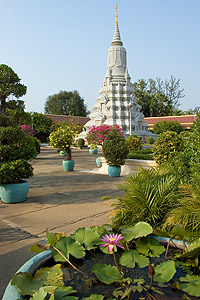
(Phnom Penh, Cambodia)
Admittedly we had a very lazy day. As a non-travel day and without any real urge to see any of the other attractions that Phnom Penh has to offer it must be admitted that we had a lie in. Not just a 9 or 10 style lie in but a fuly fledged, in your face noon lie in. After this we decided that we would hang out at a cafe on the waterfrnt for a it. This we did and Anna had the undeniable pleasure of seeing a huge rat about 2m away from our table.
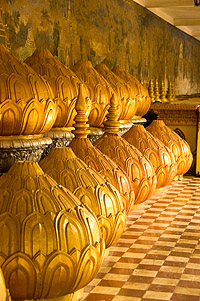
(Phnom Penh, Cambodia)
We then went to see the Royal Palace and Silver Pagoda which I must say was intensely missable. There were a lot of different buildings and several fantastic courtyards but there were just too many flag and loud hailer totting chinese tour groups. The only thing that I did take waya from there was seeing eh emerald buddha in the silver pagoda. It was spectacular, every angle you looked at it there was a different facet of translcence. The rest of the silver pagoda was full of tat and the silver tiles themselves were not on display, apart from a small section where some of them ahd been stuck down with cellotape. However the buddha was the star of the show and that was spectacular.
After the palace we did relatively little until dinner time. Here we went slghtly upmmarket and ate at a French hotel with the dream of getting a decent steak. Our meal was pretty good on the whole but what I found odd was that the steak had bee flown in from Argentina - bizarre considering that the cow was the most common animal I had seen in the countryside, aside from water buffalo that is. Also the restaurant was by the riverside and Anna got her second opportunity to see a rat, this time safely through the glass windows of the restaurant.
Sunday, 30 March 2008
Siem Reap, Cambodia
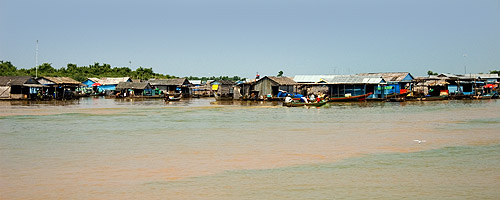
(Tonle Sap, Cambodia)
We had booked to go to Siem Reap and we were determined to do this by boat. We were warned it was the dry season and that we would first have to travel by bus, this was not an issue, come hell or high water at least some of our trip would be accomplished by water. We turned up at 0700 at the boat station and encouragingly there were other toorists there. If we were going to suffer so would they. We were then piled into a small bus with insufficient leg room for a leprechaun and driven for 3 hours to the place where we boarded the boat. Well I say driven but in fact we had an un-needed stop for breakfast at around 0930 at a flea bitten way stop.
When we were disembarked we found oursleves on a muddy riverbank, no problem for us but a big problem for the Americans with wheelie suitcases. However more of a problem was that there was no vessel big enough looking to take all of us. However we were pushed towards a rotting old fibreglass boat and all clambered aboard. Its not that we have high expectations of transport, indeed we have taken many different forms of transport with all sorts of quality. But the peculiar thing in Cambodia was that tourists were being shunted around on the most decrepit vehicles imagineable, whereas the transport for locals was much better. Nevertheless we jumped on the boat and proceeded to set off.
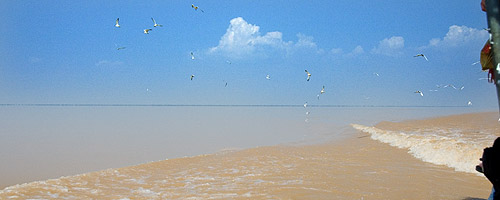
(Tonle Sap, Cambodia)
The first part of the journey was idyllic, cruising along a creek that led into the Tonle Sap. Populated by all sorts of floating houses it was our first chance to see a slice of life on the lake. The lake itself is unusual as in the rainy season water flows out of the Mekong at Phnom Penh and fills the basin in the centre of Cambodia. However in the dry season it starts to flow out again leaving plentiful fertile floodplains and a very shallow lake. This was in fact the whole problem with our trip, the locals of course knew that during the wet season the lake was the fastest route as huge catamrans could plie the route from Phnom Penh to Siem Reap, however in the dry season it is shallow only very small, slow boats can navigate it and the journey takes 9 rather than 6 hours.
The most uncomfortable aspect of being crammed into this tiny boat was that there was only outside shaded seating for around six people. Everyone else had to sit in the non too salubrious below decks or on the roof of the boat. We took the roof until about two hours in when we realised we were going to get burnt to a crisp. We were fairly lucky that we bailed fairly early as there was not enough space for everyone below decks, I watched one Dutch chap turn lobster pink on the trip. Even then Anna managed to burn her legs so severely that she had to wear trousers for days afterwards. Added to this was a factor of tedium. The lake, which was literally only feet deep for most of the journey, had nothing in the way of landmarks so it was several hours of staring at the same view.
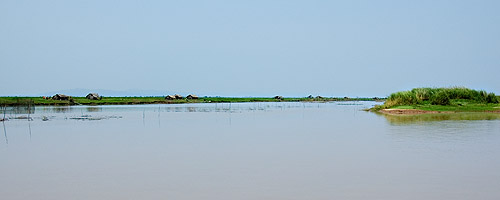
(Tonle Sap, Cambodia)
We finally pulled into a creek at the other end of the lake at around 1600. The creek was like a boat motorway with tons of boats coming out to go to visit the floating villages but we slowly crept our way up to another muddy riverbank where we stopped. Here, like some parody of arriving at an airport, ten or so tuk tuk drivers waved placards with our names on. We found ours and sped off into town along a rutted dirt track. In town we had to find a hotel which in theory should have ben easy enough - you just get in a tuk tuk and drive around then one of you pops out and takes a look at each hotel. However the first place pulled a bait and switch tactic on Anna, first showing her a lovely room, then when we had unloaded our luggage and were about to check in we were told that the room was not free and the alternative was a bit dingy. In disgust we walked out to load our luggage onto another tuk tuk and continue the search. In the end we found a large room pretty cheaply at a hotel in the North of town.
We had dinner that night at Cafe Indochine. They did an excellent set Khmer meal with Crab and pomelo to start with, followed by an excellent lobster soup and a couple of main courses. One point however must be made about the cuisine, what we tried at least, was that it is not spicy as you would expect. A lot of things are for example served with a subtle fresh pepper sauce. So whilst in Cambodia we generally oscillated between French and local food to get a bit of variety of flavours.
Monday, 31 March 2008
Siem Reap, Cambodia
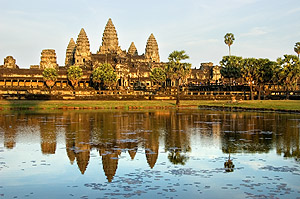
(Siem Reap, Cambodia)
We got up relatively late and did not start heading towards Angkor Wat until around 0930, and since we had to hire bicycles and had to buy our pass for the week it was not until around 1100 that we got to Angkor Wat. It was crawling with tourists and the light was very harsh for photography but it was stunning. You approach from the South and then cycle along the South and West sides of the moat before you get to the entrance causeway. The moat itself is impressive enough, 2km long on each side and 200m wide even at this point in the dry season it was still relatively full. I assumed that it is filled from the Siem Reap river and that unlike the majority of other moats - for example that of Angkor Thom - efforts were made to keep it clean and the water flowing throughout the year. Charmingly the thin strip of land just outside the outer enclosing walls has become overgrown with trees over the years and there were some with huge canopies, almost giving the island the look of a British park set on an island in the middle of the jungle.
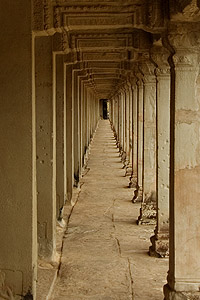
(Siem Reap, Cambodia)
The causeway leads to a 250m long entry gate through which is another 350m long causeway flanked on either side by naga rails. These are representations of a multiheaded sea serpent and are seen repeatedly throughout Khmer architecture. The central temple itself with its five distinctive corn cob shaped towers, representing the five peaks of Mount Meru, looms large at the end of the causeway and as you get closer you start to realise how detailed it is. Literally every surface is covered in bas relief workings. The outermost wall is nearly 200m on each side and the 700m total length divided into eight friezes depicting various tales and battles from the Hindu based mythology which prevailed at the time. Chief amonngst these is the panel depicting the churning of the sea of milk, a myth in which the gods and the demons coil a serpent around Mount Mandala, which is perched on a turtles back, and use it to try to churn the ocean to produce the elixir of immortality.
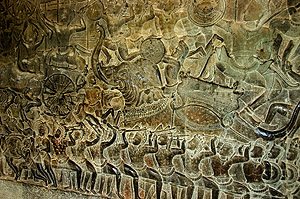
(Siem Reap, Cambodia)
Inside these walls is yet another square walled enclosure and within this the temple representing Mount Meru with its five distictive towers. This last inner temple is inaccessible due to people falling from its steep steps. In hindsight this was very odd since steep rises of steps are very common in Khme temples and here, unlike some, they had at least put in a wooden staircase. Thus we had to content oursleves with looking at the carvings of Apsaras, or dancing girls, of which there are over 1500 unique carvings at Angkor, perhaps reflecting some of the army of 3000 dancing girls that each Khmer king would support.
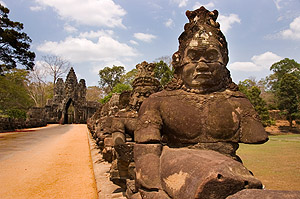
(Siem Reap, Cambodia)
After Angkor Wat (well our first visit there as we were to go back a few times) we cycled on to Angkor Thom. Whilst Angkor Wat was thought to be both a temple and a mausoleum for the Khmer kings Angkor Thom was their city. A lot of the buildings were wood build so little remains apart from the monumental showpieces. Approaching the first thing that hits you is the walls and the entry causeway. This is truly spectacular with a balustrade of devas and asuras either side tugging at a serpent to churn the sea of milk. In a mixing of faiths however the gate itself is topped by a four faced head of the benevolent Bodhisattva Avalokitesvara which is another theme repeated during the golden era of the Khmers, during which a couple of the kings embraced Buddhism.
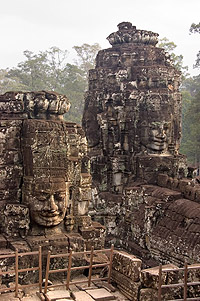
(Siem Reap, Cambodia)
Once in Angkor Thom we headed directly for the Bayon. This is without doubts one of the highlights of Angkor depite the constant stream of tourists. From a distance it looks like a jumbled mountain of rocks, it is not until you get closer that you begin to make out the design. There are 54 separate towers each depicting the head of Avalokitesvara, all laid out in three concentric interlocking walls. The end result is something of a very symmetric maze, as you find your way up to the next level you can see the vaulted barrel roofs of the level below you and are face to face with its serene Buddhist faces. In terms of the sheer vision of being able to create something so complex and fun to explore the Bayon is one of the high points of Angkor.
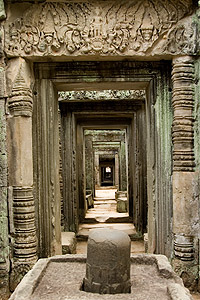
(Siem Reap, Cambodia)
Finally we got back on our bikes and went to visit Preah Khan, another temple which served as king Jayavarman Vii's home whilst he restored Angkor Thom after it was sacked by the Chams (an Islamic race from the Vietnam area who were eventually absorbed into the Khmer) in 1177. This was in a very ruined state and you could do little more than walk through an endless series of doors to the heart of the sanctuary and then out the other side.
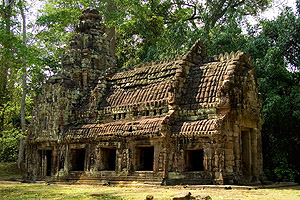
(Siem Reap, Cambodia)
By then it was around 1430 and we were both pretty exhausted from the heat so decided to head back. However just after Angkor Wat, about 6km out of town the winds started to pick up and some very dark clouds came in, and we were treated to a storm. We were very lucky because just when it became apparent we could not go on we arrived at a fork in the road where there was a small shelter of the kind you see all around Cambodia for passing travellers. We could now see its purpose, as soon as we dived in various groups arrived abandoning their motor scooters and taking cover. In the end there were around fifteen people sheltering from what was torrential rain with thunder and lightning and lasted about an hour. It should be noted however that very few locals took shelter, a lot just carried on cycling around taking the sheet rain in ther stride.
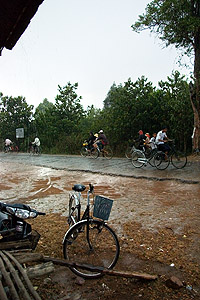
(Siem Reap, Cambodia)
Even when the rain had stopped and we got back on the road the tribulations were not over, we still had to contend with water on the road - in places 20cm deep - which meant our feet were dipping into the water as we cycled. This made negociating the traffic more difficult, not that easy in a place where everyone just pretty much drives where they want to drive and turning is a matter of blind faith as the traffic, mainly motorcycles, just tends to be non stop and people simply merge through each other. Even crossing the road is a matter of faith, as in a lot of countries with very few traffic lights you simply just have to ait until there are no cars coming then launch yourself into the road hoping that the motorcycles weave around you - as they do if you act positively.
That night we ate at Les Malraux, a French bistro with good food, I had foie gras followed by magret de canard. The only puzzle was that we were about the only customers there apart from a group of five local girls. We had run into this before and I was beginning to suspect that maybe the French do not like eating their own cuisine abroad - but maybe we were just lucky.
Tuesday, 1 April 2008
Siem Reap, Cambodia
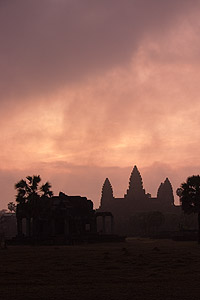
(Siem Reap, Cambodia)
We had arranged with the chap who had given us a lift from the ferry docks into town to take us to a few further afield temples, starting with Angkor at dawn. This somewhat surreal experience involved us getting up at 0500 then having to wake up a member of staff as the hotel gates were locked despite us telling them the night before. We then set off into the night in our tuk tuk. I would like to pretend we were the only ones but it was in fact like te wacky races getting to Angkor Wat, with tourists in every manner of transport from bicycle to coach trying to get there before the others. Naturally the Chinese were there in force with guides with flashing light wands to keep their parties together.
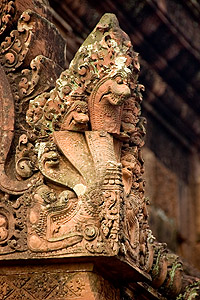
(Bantaey Srei, Cambodia)
It was at least easy finding a good spot and we got a few good photos in from a distance and then walked closer to the two pools - seemingly designed for the use we were putting them to now, gazing at the temple and its reflection at the same time. However one issue was there was total cloud cover, and our next destination being a good way away, and us having the chance of being first there we decided to leave. Somewhat sady this was a bit too early, as we were driving away from Angkor Wat an amazingly red disc made a very brief appearance between two slivers of cloud. I was at least able to catch it above the moat of the Wat.
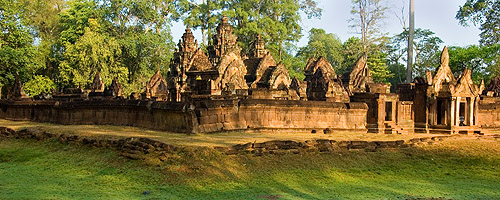
(Bantaey Srei, Cambodia)
The next destination was over 30km away and was a bit of a treat. Bantaey Srei is known for being the pinnacle of ornate carving and bein gof pink sandstone is an absolute winner for first thing in the morning. We were unfortunately the second people there by a whisper but between the two sets of people we had the place to ourselves, which given how compact and intricate it is was more than enough. Oddly it was not built by a king but by two rich brothers. About 200m in length it has all the elements of Angkor but the difference being that whilst Angkor is almost covered in carvings not one single centimetre of Bantaey Srei is not taken up with highly detailed ornamentation. Finally I managed to get some decent photos.
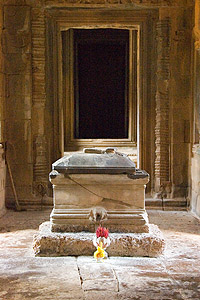
(Siem Reap, Cambodia)
Then it was off for more temple hopping. One thing has to be said for Angkor, whilst you could do the highlights (and miss the whole point) in a very long day - you could also spend an entire week there and not see every temple. The first stop was Bantaey Samre, a very well restored temple quite a distance out from Angkor Wat but on the way back from Bantaey Srei. This was perhaps the best example of one of the two types of temple we saw: the all on one level variety rather than the the pyramid shaped Mount Meru impersonations. Its distinguishing feature is that it would have had two moats, which for us meant a lot of going up an down steps to get to the centre.
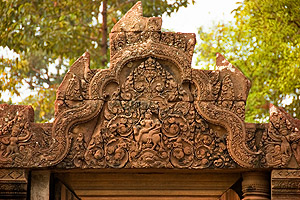
(Bantaey Srei, Cambodia)
After this we went to Ta Som, which is mainly aonther ruin that has been left to the jungle. This had yet the same one level layout but the main distinguishing feature was that a giant fig tree had consumed the head of the Lokisvara on the top of the Eastern Gopura. This was the first of the many sights of the jungle consuming the temples we saw. Finally, before we got totally templed out, we went to see Neak Pean, apparently a representation of a Himalayan lake that stood on an island in the middle of a lake. Scarily whatever this may have looked like it now looked like a collapsed victorian fountain. It took ages to get a photo without thousands of people crwawling all over it. After this we were totally templed out and so decided to go back into town.
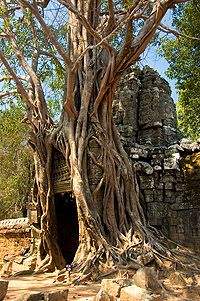
(Siem Reap, Cambodia)
There we disgracefully shifted hotel. The one we were staying in was nice but we had seen something nicer. The Hotel de la Paix is an exceptionally well designed boutique hotel, minimalist with the ocassional hint of Khmer archirecture. It has a spa and a first floor swimming pool with an infinity edge which sort of gave it the effect of looking lke you were heading towardsa waterfall in the jungle. In short with four more days of our holiday left it was time to trade in the backpack and settle nto some well deserved luxury.
After extensive hanging around in our hotel we emerged at 1630 to meet up with our driver again and go to see the sunset somewhere Sadly we took his advice this time and instead of hitting Angkor Wat in the reddish tones of the afternoon we decided to go for the only place he reckoned you could actually see the Sunset - Phnom Bakaeng. This is the ultimate in temple mountains, where a 60m high mountain had been taken and covered in stone staircasesand ramps and a standard three tier purami placed on top. Sadly it seemed to be common consensus that this was the best place for sunset and as we arrived so did thousands of others, by the coachload. Everyone then teemed up the wining trail to the top of the mountain as if in some marathon and at the top there was fierce competition for places with the best view of the sun setting over the West Baray (the only one of the two colossal rectangular reservoirs the Khmers built to retain water for agriculture with water in).
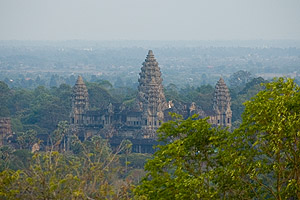
(Siem Reap, Cambodia)
The irony is that I did not get one single shot. Again the sun was behind clouds and whilst I would have stayed, at ten past six we started to get kicked out of the temple. But this irony was compounded when, as we were making our way down the montain track the sun popped out for five minutes from a crack between two clouds. Predictably there were trees in the way and I and the legions of the photographically disappointed ran around trying to find a gap, or waving our cameras above our heads trying to take pictures blind. This was all to no avail, the only thing I managed to get from the whole exercise was an aerial view of Angkor Wat.
After this we went and had dinner in Siem Reap's old market where a small alleyway contained a handful of eateries. We again were back to Khmer and went to a place called Champeys, amusingly composed of three or four colonial era shops in an even smaller side alley which had had their walls removed so that the whole experience was of eating in distinct places. This effect was amplified by the fact that the restaurant had a series of power cuts and as lights and fans in one "house" of the restaurant were restored they would magically cut off in another. The food was nice but pretty bloating as rice was served with everything.
Wednesday, 2 April 2008
Siem Reap, Cambodia
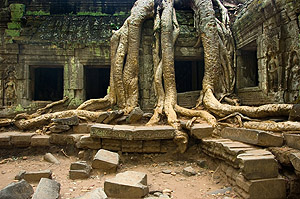
(Siem Reap, Cambodia)
We had realised that you do not get much enjoyment out of Angkor in the hot season if you start off late. So we got out of bed at around 0700 and made our way in a tuk tuk to Ta Prohm. We should have learnt our lesson from Bantaey Srei. By the time we got there at around 0900 the sun was already too bright and swarms of Chinese and Japanese tour groups had descended on it. This was a shame as it really is one of the most impressive temples. Of the one storey layout what distinguished it from the crow is how completely the jungle has overtaken it. Massive Kapok trees grow on everything, there feather like seeds floating to small pools on the tops of buildings, then their roots growing downwards to reach the ground, eventually becoming huge butress roots. I think I read once that this was originally an evolutionary gambit to get a leg up in the competition for light. The seeds would nestle in rain gathering crooks in trees and then the tree would grow from this position already tens of metres above ground. It would then completely subsume the other tree.
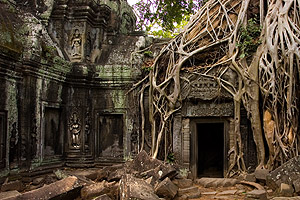
(Siem Reap, Cambodia)
Anyway at Ta Prohm they have completely subsumed the temple buildings, pulling them down in some cases, crushing them in others. The effect is of a lost city, well it would be if you managed to get there earl before the tour groups. The worst aspect was the way everyone insists on taking each others photos in front of things. My argument is that if you want to take photos of yourself either do it in well lit conditions with a neutral backdrop (or better still stay at home and do it). If every single person in a twenty person group feels they have a picture of themselves sandwiched in between two butress roots it completely prevents others who want to recreate the lost world look in their photos. Despite this and the raking light I managed to get a couple of decent shots in before we moved onto the next place.
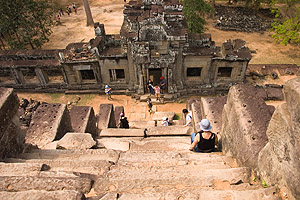
(Siem Reap, Cambodia)
Ta Keo is the epitomy of mountain pyramid temples with three incredibly steep tiers of stairs with a flat top with five towers representing the peaks of Mount Meru. This was really steep and although it was trivial getting up, getting down was a little hair raising. Each tread was about 15cm with a rise of 60cm, making falling over a potentially fatal experience. We had a mooch around and decided it was the last pyramid for us as the rewards at the top were very limited, although there was a cooling breeze there was very little shade. Lastly we explored Angkor Thom a bit more, visiting the Elephant terrace, a platform ecorated with bas reliefs of elephants on top of which the king built his wooden palace. Then Phimeanakas, the state temple at the heart of Angkor Thom which again being pyrmidal we decided to just gaze at.
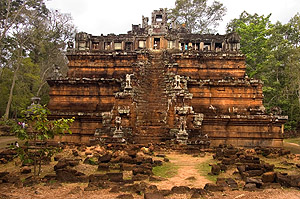
(Siem Reap, Cambodia)
Then it was back to Siem Reap for an afternoon of leisure. We had decided that we were not going to overload ourselves by trying to see everything and were content with the ten or so we had visited. So instead we had booked ourselves in for an afternoon session at the hotel's spa. This coupled with lunch at a place called Aha (which did tapas sized portions of Khmer dishes), a sleep and a few early evening drinks at the hotel took care of the rest of the day in a much needed relaxing manner. Finally we had dinner at our hotel on some very novel tables in the garden which were suspended from the ceiling like swings.
Thursday, 3 April 2008
Siem Reap, Cambodia
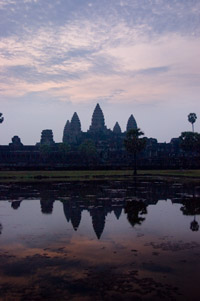
(Siem Reap, Cambodia)
Sadly it took us until our last day to devise the perfect programme in terms of getting the most out of the light and not getting too hot. We got up at 0500, grabbed a tuk tuk and went to try and catch the sun rise at Angkor Wat. To no avail, the clouds looked promising but the sun never appeared and there were a lot of glum faces at what I had now christened the "lake of disappointment". Then it was off to the Bayon to try and get some photos in the softer morning sun. Ths was much more successful, the place was very quiet and we were able to crawl all over it over the course of an hour and a half. I was also rewarded with the sun poking through the clouds on a number of occasions so was able to get some good shots. We also got to explore a bit more and see how truly maze like it is, as well as work our way around the frieze panels on the outer walls.
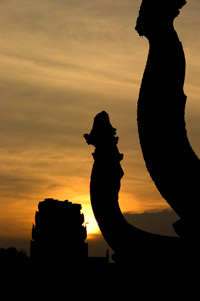
(Siem Reap, Cambodia)
We got back to the hotel at 0930 and then had some breakfast followed by some sunbathing, swimming in the pool and sleeping. Then at 1500 we went out and hired bikes to catch the late afternoon sun. Whilst cycling at this time sounds a little crazy it is not that bad as the wind keeps you cool and the last half is shaded by a beautiful avenue of Dipterocarp trees. We got to Angkor Wat around 1600 and ten had a chance to take some pictures. I was particularly interested in capturing a set of Apsaras or dancing girls of which there are 1500 individualised portraits around the temple. We also took a walk to the Souhern Gopura and to the shores of the moat where we caught some local boys paddling back to the other shore, perhaps in a move to avoid the entry guards. As we left the sun was just setting and this time I was able to get a few photos.
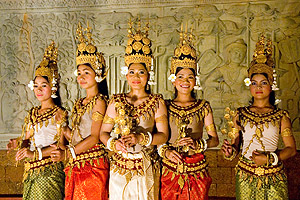
(Siem Reap, Cambodia)
That night we had booked to see an Apsara dance at the Grand Hotel D'Angkor, one of the most traditional hotels in Siem Reap. We thought this would be a fairly traditional affiair, unfortunately it was just a buffet of huge proportions with about 200 chinese tourists to jostle with. The worst thing was that they all left das soon as they had finished their buffet, during the middle of the last dance. This left about ten of us clapping at the end. After this we briefly explored pub street - Siem Reap's tourist bar centre before heading to bed.
Friday, 4 April 2008
Bangkok, Thailand
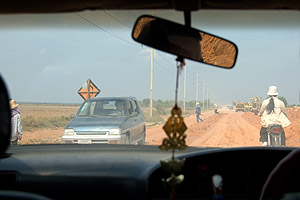
(Bangkok, Thailand)
We had booked a taxi to go to Poipet, the border with Thailand and the route back to Bangkok. We had been warned it was a bad road and the best way to avoid a six hour epic on a bus was to hire a car for $30. When our car turned up at the front of the hotel de la Paix it was a bit of a shock. It was a fairly road weary Toyota Camry with a dust filled interior. In retrospect this was not that surprising as it turned out the road was much worse than even we had feared. In fact the term road proved to be a bit of an exaggeratio It was more like a selection of potholes interlinked by a thread of tarmac. In fact so bad was the quality of the surfaced parts that it was a blessing when it was replaced by dirt tracks. What made it even worse was was the fact that the Cambodian government were in the process of rebuilding it so in many places we had short muddy detours to avoid bridges which were in the process of being built.
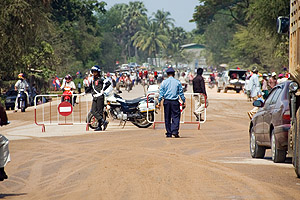
(Bangkok, Thailand)
However we had allowed time for this, what really delayed our trip was totally unanticpiated - a state visit by the Pesident of Cambodia. For some reason he had chosen that da to open a university in a town along the way. We were first stopped at one road block and told that they were stopping the traffic for two hours. However after a lot of shouting by various people the police gave in and let everyone through. But then, about half an hour more down the road, we were stopped again and had to wait about an hour and half. Nearly half of this was to let all the visiting miltary and state cars out. A seemingly endless convoy of four whheel drive vehicles with the windows blacked out and either green state plates or blue and red army plates. The president himself got out by helicopter, hardly a surprise that he would not travel by road himself, it would have taken a good seven hours back to Phnom Penh. Whilst we waited we also watched the front tyre of our car deflate - it had a slow puncture.
We finally got going again aroung 1145 and then had to pump the wheel back up as well as overtake a large number of tractor pulled carts full of people who had been watching the president's visit and were now on their way back to their villages. We finally got to the border around 1245 and then had a series of waits and a long trek between the two border posts. For some reason the no-mans land between the two borders was lengthy enough to accomodate a couple of casinos. On the other side we leapt in a tuk tuk and quickly found a 1345 bus heading to Bangkok, a four and a half hour trip.
The trip to Bangkok was fairly unventful with only one near collison. Once at the Northern bus terminal we grabbed the much more convenient skytrain into the centre of town and our hotel which was in a skyscraper near the river South of the centre. It was 2000 when we got to our room on the 58th floor and we did not have much energy to venture outside our hotel. Fortunately our hotel had some stunning restaurants and we ate at one of their al fresco restraunts on the 51st floor. Sitting their high above the city it was very easy to see that Bangkokcould be a lot nicer place than we had thought from previous visits, if you were prepared to spend the money.
Saturday, 5 April 2008
Bangkok, Thailand
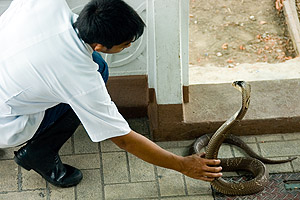
(Bangkok, Thailand)
Our last day and it was honestly a bit of struggle coming up with some things to do in Bangkok as we were templed out after Angkor Wat. So we decided to head for the snake farm, a red cross facility for breeding venemous snakes to produce anti-venom. This is quite a fun excursion because as well as seeing some of the most posionous snakes on the planet they treat you to a snake handling exhibition. In some cases like the King Cobra this was rather subdued but the Monocled Cobra was a nasty piece of work and kept trying to strike the handler.
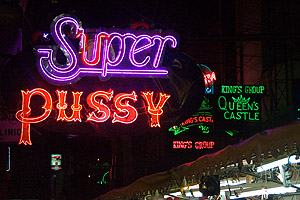
(Bangkok, Thailand)
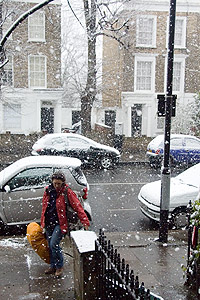
(London, UK)
We then went and did some shopping at Siam Square which was pretty fruitful in that we managed to find a lot of contemporary craft work and although the prices were higher than you would see out in the countryside the end products were a lot better finished and the range more varied. We thenwent for a lengthy early dinner, which worked out well as we arrived at Jim Thompson's Saladaeng Cafe during the 3-7 happy "hour", and had an excellent Thai meal. Finally, as it was on the way back to the hotel we also took a look around Patpong, Bangkok's red light district and the scene of some quite hair raisining ping pong antics.
With some sadness we caught a late night plane out of Bangkok and headed back to the UK. One surprise we had in store for us when we got back, it was snowing! Having suffered 35°C temperatures day in day out we arrived to a very unseasonal 1°C and snow.





